
The IoT hype in insurance continues unabated, with new research by NTT DATA suggesting that 3 out of 4 insurance carriers believe IoT will strongly influence their future products and services. Titled “IoT: Disruption & Opportunity In The Insurance Industry,” this U.S. based study surveyed end consumers and decision makers in carrier organizations on the subject of IoT devices in the home (thermostats, smoke alarms, garage door openers, door locks and bells). A few research findings for the two groups stood out to us.
Consumers are divided on their readiness to change
Two cohorts emerged from the consumer research, which also reflects in their views about smart home technologies. 64% of consumers surveyed, or the “Seekers” are younger, less loyal to their carrier, price-sensitive and want more personalized products and service. Unsurprisingly, the Seekers want their carriers to be more innovative and are more willing to share varying degrees of smart home data in exchange. The remaining 36% are the “Keepers,” older policyholders that feel protected by their current policies and are unlikely to make sudden switches. Overall, 50% of the consumers expected to buy smart home devices in the future despite privacy and security concerns, but the majority find current products to be expensive and complex: I still haven’t rigged up my “smart bulbs,” gifted over Christmas by a tech-savvy relative!
Insurance carriers get the importance of IoT
87% believe IoT will improve customer relationships, 83% see it as an opportunity to attract new customers, and 74% see IoT as having a significant influence on products and service. Already, 77% are ramping up IoT initiatives, with customer service and technology use cases at the outset. The major challenges for carriers are the inability to get smart home data (68%), building analytics into underwriting processes (62%) and the expenses of the carrier or customer buying and installing smart home devices (55%).
In my conversation with Normand Lepine, NTT DATA Consulting’s Sr. Director of Insurance Data and Analytics, he pointed out, “Carriers recognize the opportunity to expand their value proposition with clients through IoT. In the next year, pilots, strategy and lab work around smart home technologies will help carriers create new products and services.” We believe each carrier that is experimenting with smart devices will go through a calibration process with customers, all centered around one factor – data and how to use it to create meaningful products and services. NTT’s survey data hints at this as well, with the lack of data being a carrier challenge, and consumer responses suggesting that they are willing to share only certain types of data, depending on their demographics and lifestyles.
Implementing connected insurance solutions requires carriers to rethink major business functions towards becoming digital organizations.
Let’s consider the customer lifecycle as an example. Carriers will need strong, mobile-first, sales and marketing channels to attract and transact with the “Seekers.” They can leverage smart home device technology to offer two key benefits to customers – a more personalized service experience, and cost savings in the form of usage-based risk and premium determination (an “As-a-Service” offering). This customer acquisition effort will need to have straight-through processing, with smart underwriting powered by real-time profitability analysis. When it comes to customer service experiences, smart devices again play a few roles, such as providing insights (e.g. smoke alarm data) that can be made accessible to customers with recommendations on usage. If a carrier is interested in smart home technology to drive new customer experiences, customer interaction touchpoints can be reimagined with the help of interactive personal assistants (e.g. Amazon Echo). These at-home assistants can intelligently converse with policyholders for simple service requests throughout the customer lifecycle (as Nationwide, Grange Insurance and Safeco have started to do).
In addition to home insurance, we also see examples of carriers exploring IoT- enabled auto insurance, and large-ticket opportunities in areas like commercial insurance. What will be interesting to watch is the role that technology and business service providers play in this evolving market. From IoT infrastructure services to the design, development and running of the related data and analytics infrastructure and services, IT services such as IoT app development, platform migrations, and micro-services, consulting/advisory on new product development and rapid prototyping/testing of IoT offerings, partnering with device manufacturers (particularly niche, insurance-related startups), we see several new opportunities for service providers.
While IT and business services providers are investing in IoT offerings as a horizontal capability, carriers will need to find the ones that are doubling down on insurance, with the appetite to invest in the industry specifically. The survey data makes this much clear – both consumers and carriers are getting ready for IoT-led change. The question is—will the service providers be able to embed themselves as “As-a-Service” partners to the emerging “connected insurance” economy?
Posted in : The Internet of Things







I can’t wait to see insurance carriers bringing Alexa / Google Home to buy my auto and home insurance and ask quick questions or even basic processes like roadside assistance.